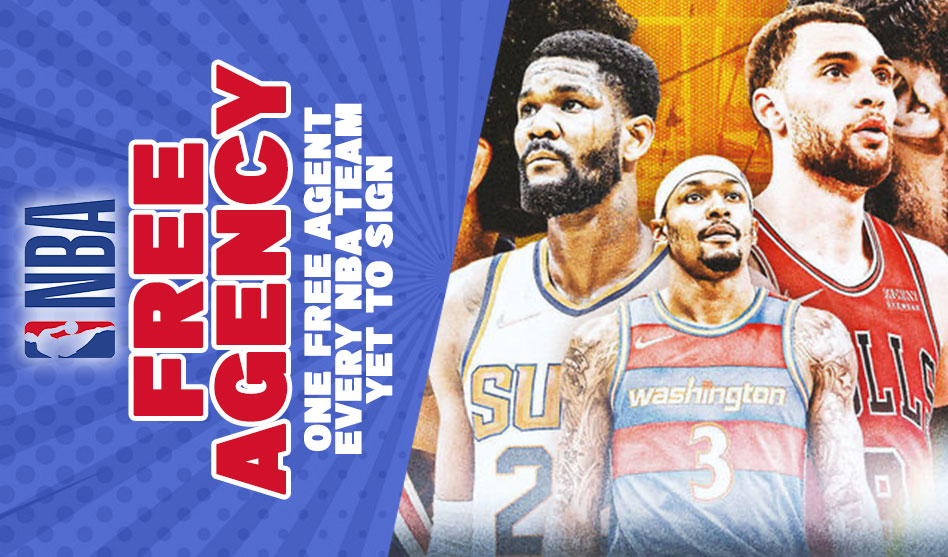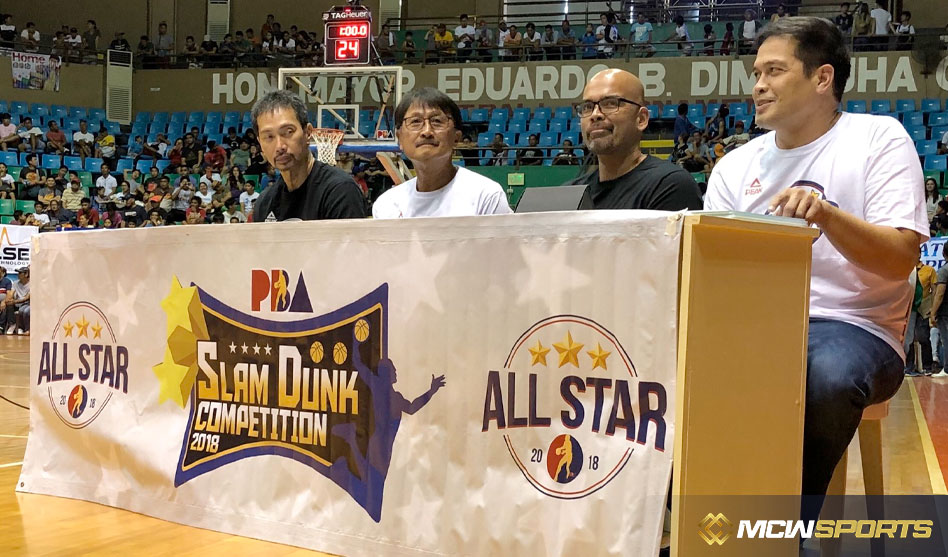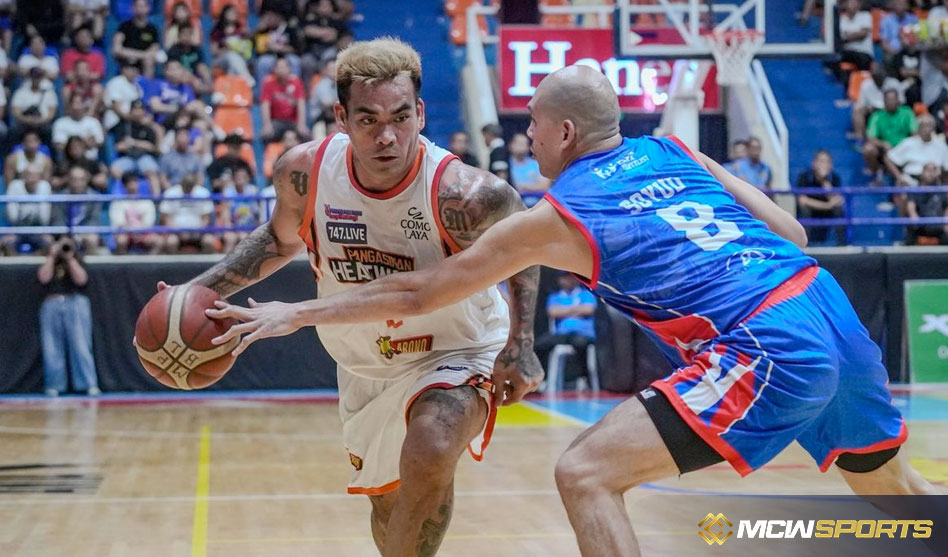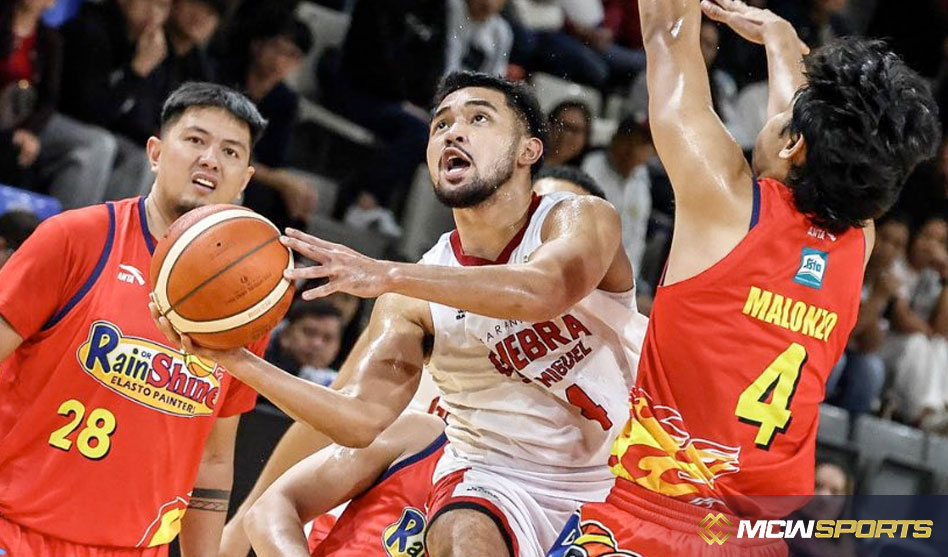This content has been archived. It may no longer be relevant
Teams have accomplished a ton during the early part of 2022 NBA free agency.
The New York Knicks finally found their point guard in Jalen Brunson. The Philadelphia 76ers snagged what they hope will be the missing piece of their championship puzzle in P.J. Tucker. The Portland Trail Blazers fortified the defensive end with Gary Payton II. The Sacramento Kings increased their offensive potency with Malik Monk.
Oh yeah, and the Washington Wizards (Bradley Beal) and Chicago Bulls (Zach LaVine) locked down their stars for the long haul.
Still, there is more work to be done: more money to spend, more needs to address and more hidden gems to uncover. Considering roster dynamics, cap situations and everything in between, we have identified one free agent every team should still have on the radar.
Atlanta Hawks: Kessler Edwards
Atlanta assembled one of the Association’s best backcourts by linking Trae Young and Dejounte Murray together, and this frontcourt may remain crowded until a John Collins trade actually happens.
The wing rotation, however, needs help, and that was true even before the Hawks sent Kevin Huerter to Sacramento. Prying Kessler Edwards would be a fascinating way to address that void.
Edwards impressed in a three-and-D role as a rookie, splashing 35.3 percent of his perimeter shots and holding his own in mostly difficult defensive matchups. With his 22nd birthday approaching in August, he is the perfect age to grow with this core.
Boston Celtics: Dwight Howard
The Celtics need more size and length on the interior, particularly after trading backup big man Daniel Theis.
Dwight Howard may not offer a ton during what will be his age-37 season, but he still checks those boxes easily.
It took him a while to settle into a supporting reserve role, but now he is handling the late-career wind-down just fine. He can tally an impressive number of boards, blocks and direct buckets in roughly 20 minutes a night.
Brooklyn Nets: Moses Brown
Everything in Brooklyn is in limbo now, with the futures of Kevin Durant and Kyrie Irving up in the air. Settling on the right free-agency target is tricky, then, since it is not clear what the Nets will be chasing next season.
Still, you could make an argument for Moses Brown appealing to Brooklyn regardless of which path it chooses.
If the Nets opt for a long-term rebuild, they could do worse than adding a bouncy 22-year-old who stands 7’2″ tall. If they wind up in the championship race, his size and interior activity could be useful in a high-energy, niche role.
Charlotte Hornets: Jeremy Lamb
Charlotte could need offense in a bad way. Last season’s leading scorer, Miles Bridges, could be out of the equation following his felony domestic violence charge. Gordon Hayward, the No. 4 scorer on that squad, has seen his name bounce around the rumor mill as his production has not quite measured up to his pay rate.
If the Hornets are at all worried about their attack, then they could be amenable to reuniting with Jeremy Lamb, who played some of his best basketball during his four-season stay in Buzz City.
Lamb, who peaked at 15.3 points during his fourth and final year with the Hornets in 2018-19, has lost some zip since then, but he is a natural scorer and quietly helpful rebounder. He looks great in a complementary role when his three-point shots find their mark, though that does not happen as consistently as you would like.
Chicago Bulls: Scottie Lewis
The Bulls have a full roster, so they do not have to dip back into the free-agent pool unless they really want to.
A cheap flier (maybe a camp invite?) on Scottie Lewis could be interesting enough to act.
His market might be non-existent, since he has all of seven NBA minutes under his belt, but the former McDonald’s All-American has time to find his footing with the right team. His athleticism and defense are top-notch, and he could earn a rotation role if he ever finds a consistent touch from distance.
Cleveland Cavaliers: Collin Sexton
The Cavaliers were smart to keep their options open with Collin Sexton, since he is flawed enough to think a massive overpay on him could really set a franchise back.
Fortunately, that gigantic check has not come yet, and at this point, there is no reason to think it will. With the possibility of an overpay thrown out, Cleveland should be all over Sexton.
Sure, he might functionally be a 6’1″ scoring guard, but he can play in the right role (spark-plug sixth man, perhaps?) and at the right salary. Th 23-year-old packs a mean scoring punch (career 20.0 points per game), and his presence could perk up the Cavs’ 20th-ranked offense.
Dallas Mavericks: Collin Sexton
Collin Sexton makes a ton of sense for the Mavericks. Sort of.
Few available players, if any, are better equipped to fill the support-scoring role vacated by Jalen Brunson. The guards are not Spider-Man meme mirror images, but Sexton would offer a similar array of scoring, secondary playmaking, outside shooting and energy.
The question, though, is compensation, and that is where things could get dicey. The Mavericks would need a sign-and-trade to get Sexton, and so far, it sounds like they are not bending the Cavaliers’ ear with their offers.
Denver Nuggets: Jarrett Culver
The Nuggets recognized a need for wing improvement and used it to fuel an active offseason so far. Between trading for Kentavious Caldwell-Pope, signing Bruce Brown and drafting Christian Braun, they invested assets into improving along the perimeter, particularly at the defensive end.
Rolling the dice on a discounted deal for Jarrett Culver could be the proverbial icing on the cake.
Though clearly overdrafted as the sixth pick in 2019, Culver has hardly extinguished his potential. The 6’6″ swingman competes defensively and flashes the ball skills needed to serve as a secondary playmaker. If he ever found a jumper (his 49.7 career free-throw percentage does not like his chances), he could flourish as a three-and-D swingman with some off-the-bounce shake.
Detroit Pistons: CJ Elleby
The Pistons are playing the long game, as they absolutely should be while following the lead of 20-year-olds Cade Cunningham and Jaden Ivey. After throwing one dart at Kevin Knox II, it might make sense to throw another at CJ Elleby.
He is two years into his pro career, and it still is not certain whether he can stick at this level, but the Pistons should have the time and patience to find out.
His three-ball has not fallen the way his stroke says it should (career 27.5 percent), but he could work his way into a rotation if it ever starts to. He is already an energetic, disruptive defender, and he just needs a reliable offensive role to get himself on track.
Golden State Warriors: Hassan Whiteside
The Warriors secured stability at the center spot by bringing Kevon Looney back, but they still cannot feel great about their big man rotation. James Wiseman remains a massive question mark after losing the entire campaign to a meniscus tear, and Nemanja Bjelica is out of the equation after heading back to Europe.
Golden State could use more size, and it might form a mutually beneficial partnership with Hassan Whiteside.
He can provide all the size, boards, blocks and dunks they need while they give him a platform to help restore his market. He was mostly rock-solid as a reserve for the Jazz this past season, but Golden State’s spotlight could mean more to his future earnings potential.
Houston Rockets: Luka Garza
Houston is at the stage of its post-James Harden rebuild where it can throw a ton of things at the wall and see which ones stick.
That is the kind of mentality that could steer Space City toward Luka Garza. While it is not clear whether he can defend at this level, the Rockets previously placed a similar gamble on Alperen Sengun in hopes that his offensive upside would win out.
Garza offers a similar kind of prize—provided he can defend well enough to stay on the floor. He is not the same caliber of passer as Sengun, but Garza is similarly skilled on the low post and more comfortable (and capable) scoring away from it.
Indiana Pacers: Deandre Ayton
While the Pacers seem knee-deep in a top-to-bottom rebuild, they do not have to stay down for long. Tyrese Haliburton hinted at an All-Star leap after landing in Indy at the trade deadline, Chris Duarte impressed last season with his instant-impact polish, and incoming lottery pick Benedict Mathurin could turbo-charge this perimeter group.
Indy could aim higher on the interior, though. Myles Turner is a solid source of blocks and threes, but with his 26th birthday behind him, it is fair to question whether he can grow into anything more.
The Pacers do not have to find out. They could, instead, pivot toward Deandre Ayton, the top pick of the 2018 draft, as a potential long-term building block. The 23-year-old is already a walking double-double, and he has the chance to blossom into even better on the likelihood a move away from Phoenix would include a move up the offensive pecking order.
Los Angeles Clippers: DeMarcus Cousins
The Clippers could take another shot at stabilizing the point guard position, but the addition of John Wall may have scratched that itch for good.
If L.A. is comfortable with its point guard group, then it could instead put its focus on the interior. Just last season, the Clippers were 26th in rebound percentage and 27th in paint points, and they have since seen the productive Isaiah Hartenstein take his talents elsewhere.
L.A. clearly plans on playing a lot of five-out, small-ball offense, but Cousins could help protect its spacing without sacrificing size. He has struggled mightily with injuries in recent years and wasn’t a great defender to begin with, but he can still play super productive minutes on the second team.
Los Angeles Lakers: Carmelo Anthony
The Lakers have upped their youth and athleticism on the perimeter this offseason, but they could stand to add more shot-making.
Or rather, retain the shot-making they already had.
Carmelo Anthony showed there’s more in the tank (at least on the offensive end) for the now-38-year-old. Last season, he was fifth on the Lakers in scoring (13.3 points per game), third in three-point makes (2.2) and fourth in win shares (3.6).
Memphis Grizzlies: Kent Bazemore
Last season was a mess for Kent Bazemore, but that does not mean the next season must follow that path.
Just the year prior, he was giving Golden State gobs of good minutes as a three-and-D wing. In 2020-21, he gave the Warriors 13.0 points per 36 minutes while shooting 40.8 percent from three and ranking fourth on the team with a 1.7 defensive box plus/minus.
That type of production can play, particularly on a Grizzlies wing rotation that needs strengthening behind the starters.
Miami Heat: Dennis Schroder
While Miami may not have an explicit need for a point guard, it might want more protection since Kyle Lowry is 36 years old and having increasing trouble ducking the injury bug, and Gabe Vincent has fewer than 2,500 NBA minutes under his belt.
Could that steer Pat Riley and Co. toward Dennis Schroder?
“Miami could use another veteran ball-handler as insurance for Lowry and to help keep him fresh for the playoffs,” B/R’s Greg Swartz opined. “Schroder averaged 13.5 points, 3.3 rebounds and 4.6 assists between the Boston Celtics and Rockets and is just two years removed from finishing second in Sixth Man of the Year voting while with the Oklahoma City Thunder.”
Assuming the Heat do not win the Kevin Durant sweepstakes, they will need to find ways to juice their half-court offense. Of the realistic options still available, Schroder might be the best one to provide that spark.
Milwaukee Bucks: Jeremy Lamb
The Bucks are only one season removed from winning a world title, and who knows how far they could have gone this year had they not lost Khris Middleton to an MCL sprain. In other words, if you wanted to argue Milwaukee has everything needed to compete for the crown, you might be right.
Still, the wing rotation looks a touch shallow. Adding Jeremy Lamb should be a cheap way to beef it up.
His three-ball could be more consistent, but it can be downright fiery (37-plus percent in two different seasons). He can also create offense in a pinch, which would help on nights when the Bucks do not have their full Big Three. If he is not roasted defensively, he can be helpful in the right role.
Minnesota Timberwolves: Jordan Nwora
The Timberwolves added significant size, length and defensive intimidation when they forked over a fortune to pry Rudy Gobert out of Utah. Minnesota also lost perimeter depth and long-distance shooting in the exchange.
Jordan Nwora could help provide some balance.
The 6’8″ swingman, who played everywhere but point guard last season, saw his shooting rates sink in an expanded role but also picked up his playmaking while cutting down his turnovers. If he strikes a middle ground with his three-point shooting between his rookie splash rate (45.2) and sophomore effort (34.8), he could be a real asset.
New Orleans Pelicans: Juancho Hernangomez
If you can promise the Pelicans a healthy Zion Williamson, then their list of needs becomes tiny. They could instead focus on wants and seek out a shooter with size, like Bo Cruz errr… Juancho Hernangomez.
He has suited up for five different teams in the past, three seasons alone, which might explain his recent trouble finding traction. He was abysmal in Boston at the start of last season and barely broke a sweat in San Antonio. Once he landed in Utah, though, he went for 6.2 points in 17.5 minutes per night while shooting 50.7 percent from the field and 43.8 percent from range.
If his shooting holds up, he could keep defenses honest and help open attack lanes for Williamson and Brandon Ingram. Hernangomez also has a chance to settle in quickly, since his brother, Willy Hernangomez, is approaching his third season in the Crescent City.
New York Knicks: Carmelo Anthony
Could a path open that takes Carmelo Anthony back to Madison Square Garden? Apparently, yes.
“My understanding, at least going back more than a year now, was that the idea that if Carmelo, you know, wanted to come back and, especially, like, wanted to have his final year in the NBA here, my understanding was that was on the table, and I haven’t heard anything about it being off the table,” SNY’s Ian Begley said.
An Anthony return would be objectively fun. Now, is he the cleanest fit for their increasingly young roster? No, but his locker room leadership could be beneficial for the roster, and his inevitable scoring runs (20-plus points 11 times last season) inside the Garden would feel magical.
Oklahoma City Thunder: CJ Elleby
With primary building blocks like Shai Gilgeous-Alexander, Josh Giddey, Chet Holmgren and Luguentz Dort in place, Oklahoma City can focus on finding players who make their lives easier.
If CJ Elleby’s shooting ever carries over to the Association, he can be that kind of player. And at age 22, he could force his way into his nucleus for the long haul.
To be clear, everything related to offense has been a grind through his first two seasons, as his wholly underwhelming 39.0/27.5/71.7 slash line can attest. Still, his stroke looks good and yielded good results across two collegiate campaigns (36.7 percent from distance), so this is a wager a patient rebuilder like the Thunder can make.
Orlando Magic: Dennis Schroder
Admittedly, Dennis Schroder may not be the cleanest fit for a Magic team that will want to keep developmental minutes clear for Cole Anthony, Jalen Suggs and Markelle Fultz.
Still, there are ways to find enough floor time for everyone, and Schroder could serve as a bridge to better days ahead.
First, his ability to generate offense for himself and his teammates will ease some of the pressure on the young guards and top pick Paolo Banchero to create everything on their own. Second, if Schroder is productive enough, the Magic might be able to flip him for draft assets near the trade deadline.
Philadelphia 76ers: James Harden
There is a thing about low-hanging fruit, folks: You are still allowed to pick it.
That is why James Harden is the obvious choice for Philadelphia, even if it sounds like there is no chance he would leave.
“You can expect Harden and his representative and Daryl Morey in Philly to really sit down and hammer that deal out here, perhaps as soon as the next 24 hours,” ESPN’s Adrian Wojnarowski said Tuesday on SportsCenter.
Harden’s willingness to take a relatively discounted deal opened the door for Philadelphia to add P.J. Tucker and Danuel House Jr. in free agency. Now, the Sixers just need to get Harden’s deal done to complete what they hope will finally be their breakthrough offseason.
Phoenix Suns: Deandre Ayton
There were multiple times this summer in which it seemed Deandre Ayton’s days in the desert were behind him. The first was when he was benched for all but 17 minutes of the Suns’ season-ending loss to the Dallas Mavericks in the second round, a decision coach Monty Williams described as only an “internal” one.
It felt like the market may pay Ayton much more than, whatever Phoenix felt, he was worth, but then the list of potential landing spots started drying up. It is possible the right suitor still forks over a fortune to get him, but at what point; do the Suns decide their best move is keeping him around?
He is 23 years old, productive across the board and critical to their rise as a Western Conference power. If the Suns can get him to stay for less-than-max money, they almost have to get it done, if for no other reason than to ensure they remain contenders for however prime 37-year-old point god Chris Paul has left.
Portland Trail Blazers: Caleb Martin
With the Heat tied up in the Kevin Durant watch, the Blazers should do their best to sneak Caleb Martin out of South Beach.
He is an aggressive defender who has also poised enough to put his body on the line for a momentum-changing charge call. He is assertive in the open floor and active all over.
He is also a knockdown shooter—at least; he was last season when he buried 41.3 percent of his long-range looks. That percentage may not be sustainable (he was at 24.8 the year prior), but as long as it does not completely bottom out, he could bring value to the Blazers at both ends.
Sacramento Kings: Tony Shell
If you wanted to argue for Sacramento to chase as much high-upside youth as possible, it would be hard to argue against. Saying that, though, the Kings seem more inclined to make the playoffs for the first time since—wait for it—2006.
If winning is the aim, Tony Snell could modestly nudge them that direction.
His game lacks layers, but it covers the most pressing areas for a modern forward with reliable three-point shooting (career 39.4 percent) and an acceptable amount of defensive versatility. His three-ball, in particular, should appeal to Sacramento given the spacing concerns of the De’Aaron Fox-Domantas Sabonis duo.
San Antonio Spurs: Sharife Cooper
The Spurs created a massive void in their backcourt when they moved All-Star Dejounte Murray to Atlanta. Could San Antonio look to a former Hawk to fill it?
Sharife Cooper spent last season on a two-way contract and barely saw the big-league floor. Murray’s arrival further clouds Cooper’s outlook for minutes should he remain in Atlanta, which was already blurry at best given the presence of fellow All-Star Trae Young.
The Spurs, meanwhile, could clear a path for Cooper to find significant minutes and see whether the 6’1″ guard can last in this league. His lack of size and shaky shooting are nagging concerns, but his speed, vision and selflessness could help San Antonio create its next identity.
Toronto Raptors: Deandre Ayton
Admittedly, this does not feel likely. Toronto may see enough growth potential in its current roster to eschew any major shakeups. It is also possible the Raptors only blow things up for Kevin Durant.
If neither of those is true, though, then Deandre Ayton could be a fascinating addition to this club.
He could be the interior presence they lack, and his expanding offensive range would allow him to be an impact player around the rim without spoiling the spacing. He has the length and agility Toronto favors, and even if he is not quite as versatile as the Raptors like, he can do damage as a modern-ish five surrounded by interchangeable guards and forwards.
Utah Jazz: Hassan Whiteside
When the Jazz traded Rudy Gobert to Minnesota, they armed themselves with a mountain of assets to help navigate their upcoming overhaul—with or without Donovan Mitchell. More moves are surely in the works, and one of the first orders of business is finding a new big man.
Alternatively, maybe a big man they already had, just in an expanded role.
Hassan Whiteside was rock-solid during his first season in Salt Lake City. He routinely flirted with double-doubles despite logging fewer than 18 minutes per night (8.2 points and 7.6 rebounds) while proving a reliable close-range finisher (65.2 field-goal percentage) and shot-blocker (1.6 per game).
Washington Wizards: Austin Rivers
Yes, the Wizards have tried out Austin Rivers before, and no, it did not go well. However, things could be different this time around.
In his first stint with the team in 2018, Rivers was used to a prominent role and never seemed to find his footing as a complementary reserve. Now, he is used to spending more than half the game on the sideline and finding ways to make an impact when his number is called.
He puts most of his energy into defending and is not nearly as ball-dominant as he once was which should make him a much easier fit with Bradley Beal.
Even after acquiring Monte Morris and Delon Wright, the Wizards could use more competent ball-handlers who embrace the defensive end. Rivers fits that label easily.

 English
English










